Flatbush Town Hall
Introduction
Text-to-speech Audio
For two centuries, Flatbush was a separate village in Kings County. The brick building with the three-story, square corner tower at 29 Snyder Ave. was built in 1875 as Flatbush Town Hall. Flatbush became part of The City of Brooklyn in 1894, and part of the New York City Borough of Brooklyn in 1898. The building has historical ties to the local police force and courts. The High Victorian Gothic style building became a New York City landmark in 1973, one year after it was listed in the National Register. The building was saved from demolition and renovated in the 1980s. It now holds a New York City public school for special needs children.
Images
Flatbush Town Hall looking east in 2010 (Jim.henderson)
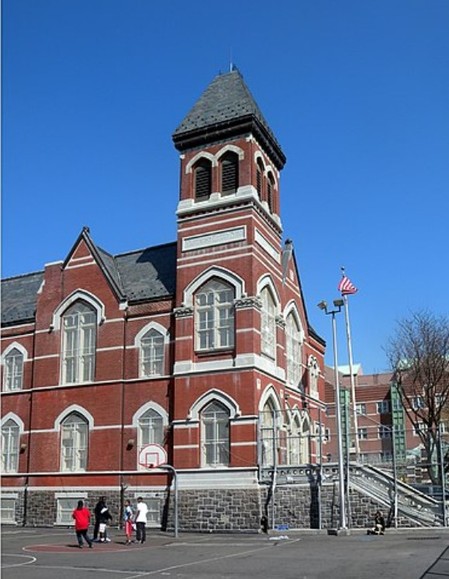
Front of Flatbush Town Hall in 1983 photo by Ning-Kang Lu for Historic American Buildings Survey (HABS NY-332)
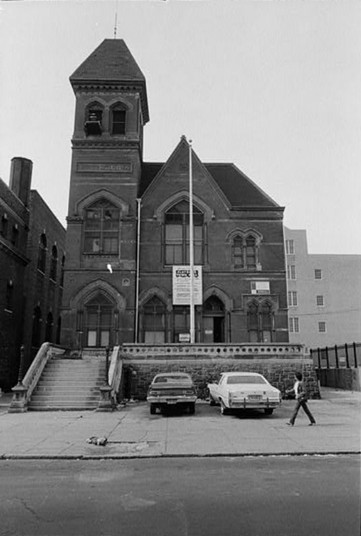
Undated historic photo of Flatbush Town Hall, facing northeast across unpaved Snyder Ave. (NYS CRIS)
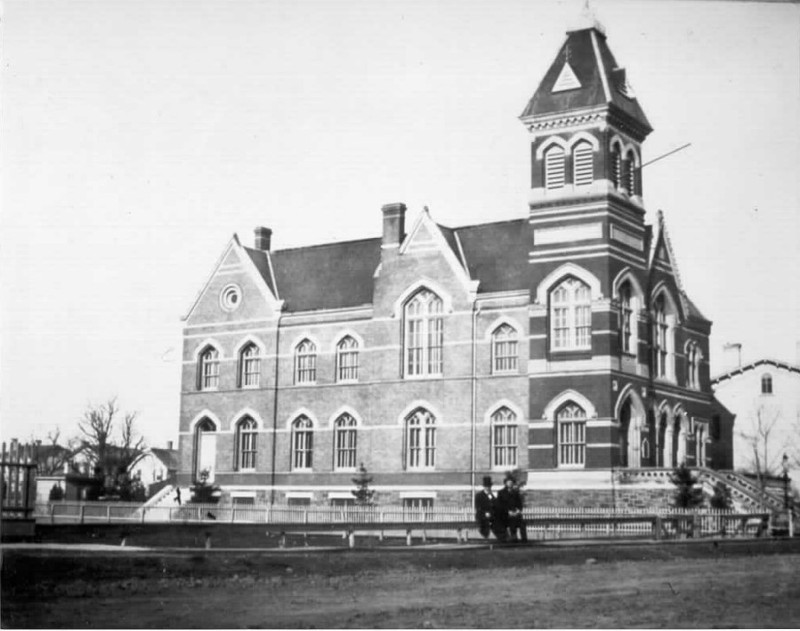
Interior view of second floor of Flatbush Town Hall in 1983 HABS photo (Lu)
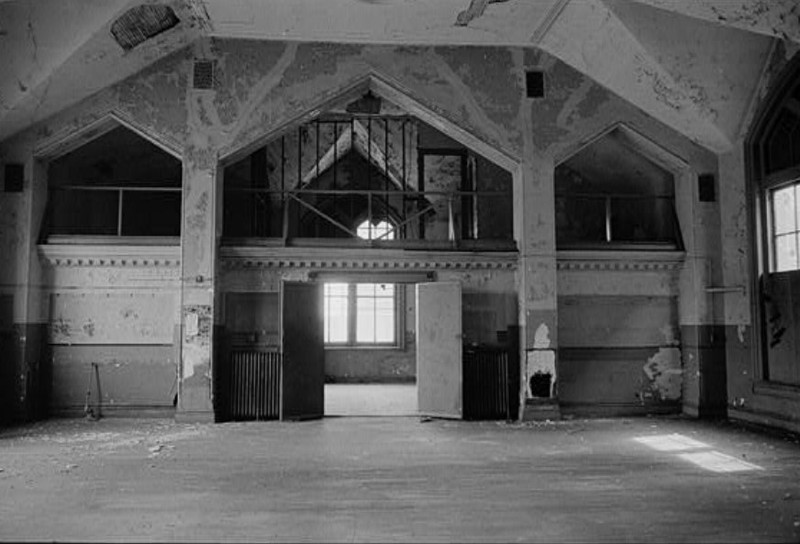
Flatbush Town Hall (green arrow) on 1890 map (Robinson's Atlas of Kings County, N.Y. p 2)
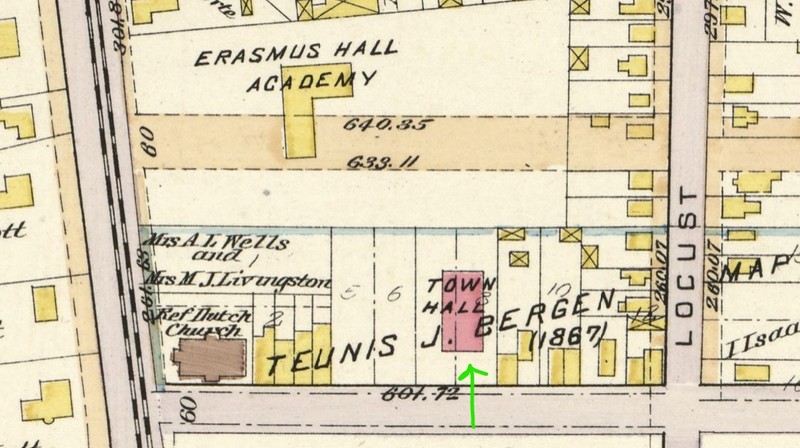
Backstory and Context
Text-to-speech Audio
The Town of Flatbush allotted $40,000 in 1874 to buy a site and build a new town hall. A "Board of Improvement" of local leaders in business, law, and medicine oversaw construction. When spending went above this amount, members of the board, which included John J. Vanderbilt and Dr. John B. Zabriskie, paid the deficit from their personal funds. The Gothic Revival style building was designed by John Y. Culyer and built by William Vause in polychrome materials. A stone plaque on the tower reads "Erected A. D. 1875." Cuyler was an engineer who helped to build nearby Prospect Park. When completed, the new town hall contained offices for all local officials and the police force. A second-floor auditorium held public meetings and events and served as a ballroom. Public offenders were jailed in cells in the building's basement. The bell in the tower rang to alert volunteer firemen of a blaze. A code was used to designate the location of the fire.
One of the performances in the second-floor auditorium was a concert by The Tennesseans, an African-American singing group, offering the "sweet, plaintive songs of the South." The December 9th 1876 event was a benefit concert for the Baptist church fund. Tickets were 25 cents general admission or 50 cents for reserved seats. The Lessing Quartet played a concert to a packed auditorium in March 1892, under the direction of Hugo Troetschel. One solo number was "Das Luftschlosschen," by baritone Dr. W.J. Schildge.
One of the prisoners held in the basement's jail cells was Mrs. Mary Dean, who was given a sentence of 30 days in March 1892 for her part in the theft of several bottles of brandy. The thief was actually Mamie Krummer, a 15-year-old, but she claimed she had been put up to the act by Mrs. Dean. Krummer was charged with petit larceny, but Dean's crime was receiving stolen goods. Krummer was paroled in the custody of an officer of the Society for the Prevention of Cruelty to Children. The crime took place at the residence of Harry Huners on East New York Ave.
After the Town of Flatbush was annexed by the City of Brooklyn in 1894, the Flatbush Town Hall lost some of its functions but was used as a community center, magistrate's court, and police station. A new courthouse was ready for occupancy in September 1923 and the courts moved out of the town hall. The building was mostly vacant from 1924 to 1926 after the police precinct (82nd) was combined with another precinct, since the structure was deemed "unsanitary and unfit for police work." Part of the back of the building was used as the Brooklyn Homicide Court beginning in late 1924. Some pushed for the town hall to be used for the Brooklyn Traffic Court; others said it could serve as a clubhouse for any of a number of local organizations. In August 1926, funds were allotted to renovate the town hall and bring the reconstituted 82nd Police Precinct back to the building, in just 40 days. The money was for new flooring on the main floor and the dormitory, and changes to the arrangement of quarters for the Captains, Lieutenants, and Sergeants, as well as the lounge for patrolmen. A future rear addition was planned for the building to give the Homicide Court more space. The police force moved out of the building for good in 1972.
Sources
Anonymous. "[Untitled]." Kings County Rural Gazette (Flatbush) December 9th 1876. 2-2.
Anonymous. "Concert at the Town Hall." Brooklyn Citizen (Brooklyn) March 8th 1892. 4-4.
Anonymous. "Mrs. Dean Gets Thirty Days." Times Union (Brooklyn) March 15th 1893. 2-2.
Anonymous. "Town Hall May Become New Brooklyn Traffic Court." The Chat (Brooklyn) June 9th 1923. Flatbush sec, 5-5.
Anonymous. "Have You Ever Heard These About Flatbush Town Hall?" The Chat (Brooklyn) April 12th 1924. Flatbush sec, 1-2.
Anonymous. "Ceremony to Open New Station House." The Standard (Brooklyn) May 2nd 1925. 9-9.
Anonymous. "Snyder Ave. Station to Open Very Soon." The Chat (Brooklyn) September 4th 1926. Flatbush sec, 1-1.
Brown, T. Robins. NRHP Nomination of Flatbush Town Hall, 35 Snyder Ave., Brooklyn, N.Y. National Register. Washington, DC. National Park Service, 1972.
NYC Landmarks Preservation Commission. Designation Report, Flatbush Town Hall, 35 Snyder Ave., Brooklyn, LP-0770. New York, NY. New York City Government, 1973.
Pearson, Marjorie. NYC Landmarks Preservation Commission. HABS No. NY--332, Flatbush Town Hall. Historic American Buildings Survey. Washington, DC. National Park Service, 1981.
https://en.wikipedia.org/wiki/Flatbush_Town_Hall#/media/File:Flatbush_Town_Hall_jeh.JPG
Library of Congress (LOC): https://www.loc.gov/pictures/item/ny1165.photos.116980p/
New York State Cultural Resource Information System (NYS CRIS): https://cris.parks.ny.gov/Default.aspx
https://www.loc.gov/pictures/item/ny1165.photos.116982p/
https://www.loc.gov/item/2011594778/
